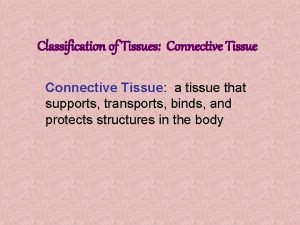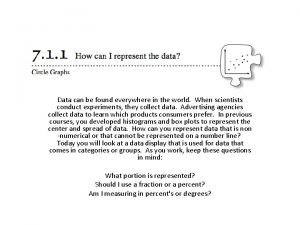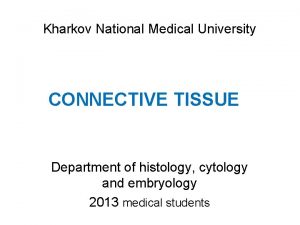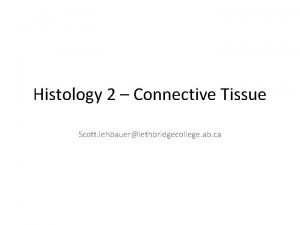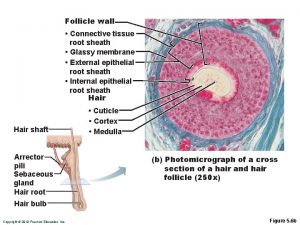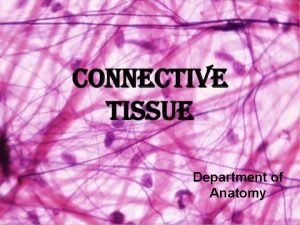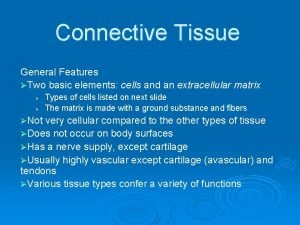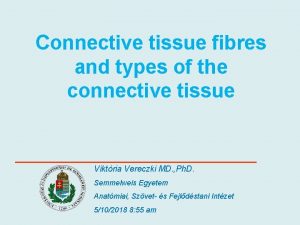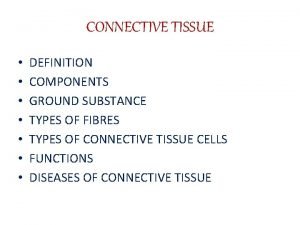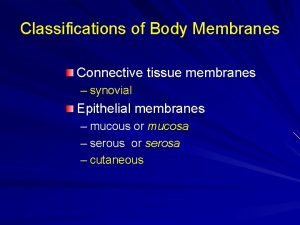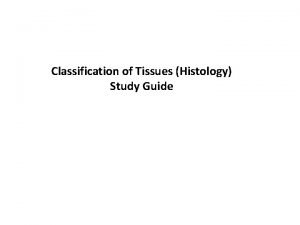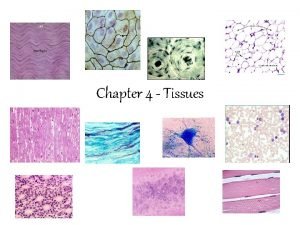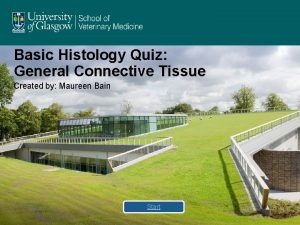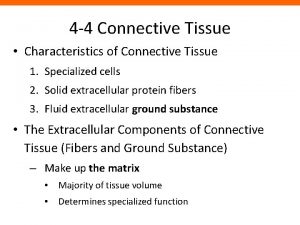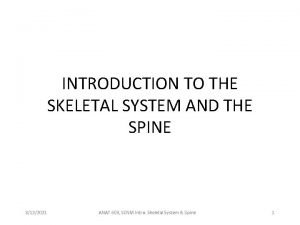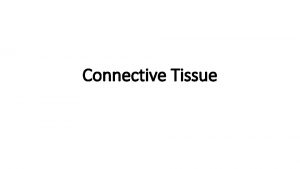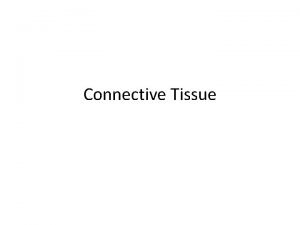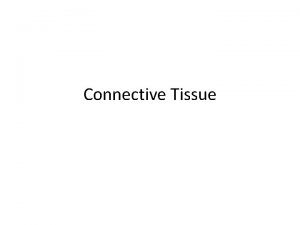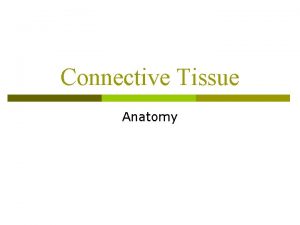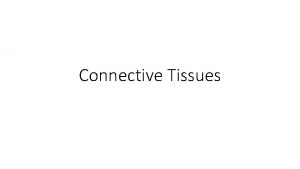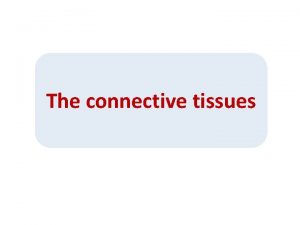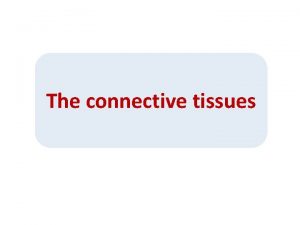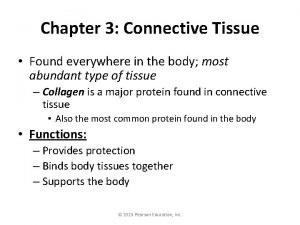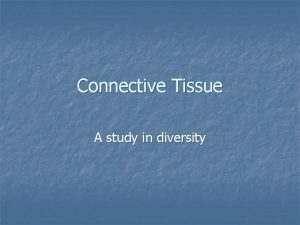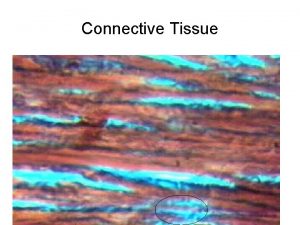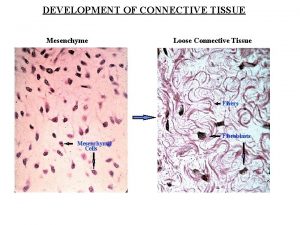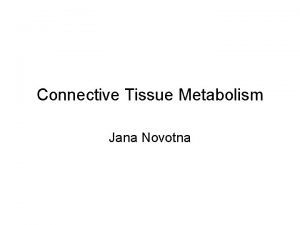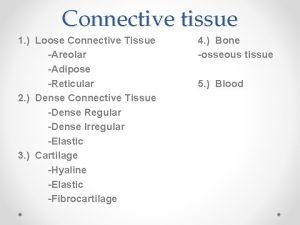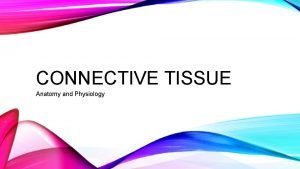Chapter 3 Connective Tissue Found everywhere in the























- Slides: 23

Chapter 3: Connective Tissue • Found everywhere in the body; most abundant type of tissue – Collagen is a major protein found in connective tissue • Also the most common protein found in the body • Functions: – Provides protection – Binds body tissues together – Supports the body © 2015 Pearson Education, Inc.

Connective Tissue Characteristics • Variations in blood supply – Some tissue types are well vascularized – Some have a poor blood supply or are avascular • Tendons, ligaments • Extracellular matrix (a unique feature) – Nonliving material that surrounds living cells – Secreted by the connective tissue cells © 2015 Pearson Education, Inc.

Extracellular Matrix • Two main elements comprise the matrix: – Ground Substance – Fibers © 2015 Pearson Education, Inc.

Extra-cellular matrix: Ground Substance • Secreted by the cells – Composed mostly of water – adhesion proteins and polysaccharide molecules (trap the water to make a gel-like substance)

Extra-cellular matrix: Fibers • Secreted by the cells – Three types: 1. Collagen (white) fibers • Allow CT to withstand pulling/tension 2. Elastic (yellow) fibers • Contain elastin- allows stretching 3. Reticular fibers (a type of collagen) • Short fibers that create a network

Connective Tissue Types • From most rigid to softest, (or most fluid): – Bone – Cartilage – Dense connective tissue – Loose connective tissue – Blood © 2015 Pearson Education, Inc.

Connective Tissue Types • Bone (osseous tissue) – Composed of: • Osteocytes (bone cells) sitting in lacunae (cavities) • Hard matrix of calcium salts – Functions to protect and support the body © 2015 Pearson Education, Inc.

Figure 3. 19 a Connective tissues and their common body locations. Bone cells in lacunae Central canal Lacunae Lamella (a) Diagram: Bone Photomicrograph: Cross-sectional view of ground bone (165×)

Connective Tissue Types • Cartilage – more flexible than bone – Found in only a few places in the body – Chondrocyte (cartilage cell) is the major cell type – Three types of cartilage: • Hyaline • Elastic • Fibrocartilage © 2015 Pearson Education, Inc.

Connective Tissue Types • Hyaline cartilage – Hyaline cartilage is the most widespread type of cartilage • Locations: – Larynx – Entire fetal skeleton prior to birth – Epiphyseal plates (ends of long bones) – Functions as a more flexible skeletal element than bone © 2015 Pearson Education, Inc.

Figure 3. 19 b Connective tissues and their common body locations. Chondrocyte (cartilage cell) Chondrocyte in lacuna Lacunae Matrix (b) Diagram: Hyaline cartilage Photomicrograph: Hyaline cartilage from the trachea (400×)

Connective Tissue Types • Elastic cartilage (not pictured) – Provides elasticity – Location: • Supports the external ear • Fibrocartilage – Highly compressible – Location: • Vertebral discs of the spinal column for cushion © 2015 Pearson Education, Inc.

Figure 3. 19 c Connective tissues and their common body locations. Chondrocytes in lacunae Collagen fibers Collagen fiber (c) Diagram: Fibrocartilage Photomicrograph: Fibrocartilage of an intervertebral disc (150×)

Connective Tissue Types • Dense connective tissue (dense fibrous tissue) – Main matrix element is collagen fiber made by fibroblasts – Locations: • Tendons—attach skeletal muscle to bone • Ligaments—attach bone to bone at joints and are more elastic than tendons • Dermis—lower layers of the skin © 2015 Pearson Education, Inc.

Figure 3. 19 d Connective tissues and their common body locations. Ligament Tendon Collagen fibers Nuclei of fibroblasts (d) Diagram: Dense fibrous Photomicrograph: Dense fibrous connective tissue from a tendon (475×)

Connective Tissue Types • Loose connective tissue types – Areolar tissue • Most widely distributed connective tissue • Soft, pliable tissue like “cobwebs” • Functions as a universal packing tissue and “glue” to hold organs in place • Layer of areolar tissue called lamina propria underlies all membranes • Can soak up excess fluid (known as “edema”) © 2015 Pearson Education, Inc.

Figure 3. 19 e Connective tissues and their common body locations. Mucosa epithelium Lamina propria Elastic fibers Collagen fibers Fibroblast nuclei Fibers of matrix Nuclei of fibroblasts (e) Diagram: Areolar Photomicrograph: Areolar connective tissue, a soft packaging tissue of the body (270×)

Connective Tissue Types • Loose connective tissue types – Adipose (fat) tissue • Many cells contain large lipid deposits with nucleus to one side (also called “signet ring cells”) • Functions – Insulates the body – Protects some organs – Serves as a site of fuel storage © 2015 Pearson Education, Inc.

Figure 3. 19 f Connective tissues and their common body locations. Nuclei of fat cells Vacuole containing fat droplet (f) Diagram: Adipose Photomicrograph: Adipose tissue from the subcutaneous layer beneath the skin (570×)

Connective Tissue Types • Loose connective tissue types – Reticular connective tissue • Delicate network of interwoven fibers with reticular cells (like fibroblasts) • Locations: – Forms internal framework of certain organs, as: » Lymph nodes » Spleen » Bone marrow © 2015 Pearson Education, Inc.

Figure 3. 19 g Connective tissues and their common body locations. Spleen White blood cell (lymphocyte) Reticular cell Blood cell Reticular fibers (g) Diagram: Reticular Photomicrograph: Dark-staining network of reticular connective tissue (400×)

Connective Tissue Types • Blood (vascular tissue) – Blood cells surrounded by fluid matrix known as blood plasma – Soluble fibers are visible only during clotting – Functions as the transport vehicle for the cardiovascular system, carrying: • Nutrients • Wastes • Respiratory gases (oxygen and carbon dioxide) © 2015 Pearson Education, Inc.

Figure 3. 19 h Connective tissues and their common body locations. Blood cells in capillary Neutrophil (white blood cell) Red blood cells White blood cell Red blood cells (h) Diagram: Blood Monocyte (white blood cell) Photomicrograph: Smear of human blood (1290×)
 Define connective tissues
Define connective tissues Where is adipose connective tissue found
Where is adipose connective tissue found What connective tissue
What connective tissue Everywhere you go everywhere you look
Everywhere you go everywhere you look Information can be seen everywhere
Information can be seen everywhere Connective tissue specialized
Connective tissue specialized Nerve tissue description
Nerve tissue description Fibrocytes
Fibrocytes Hyaline cartilage function
Hyaline cartilage function Glassy membrane histology
Glassy membrane histology Regular connective tissue
Regular connective tissue Where
Where The dominant fiber type in dense connective tissue is
The dominant fiber type in dense connective tissue is Adipose tissue function
Adipose tissue function Connective tissue components
Connective tissue components Reticular fibers definition
Reticular fibers definition Areolar vs reticular connective tissue
Areolar vs reticular connective tissue Classification of body membranes
Classification of body membranes Embryonic connective tissue
Embryonic connective tissue Fibrous tissue
Fibrous tissue Connective tissue histology quiz
Connective tissue histology quiz Supportive connective tissue
Supportive connective tissue Connective tissue characteristics
Connective tissue characteristics Embryonic connective tissue
Embryonic connective tissue

